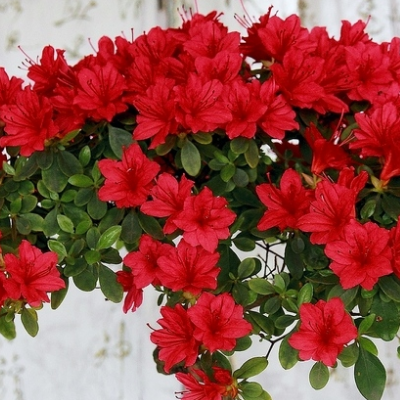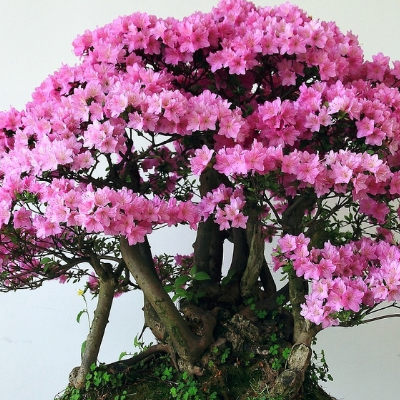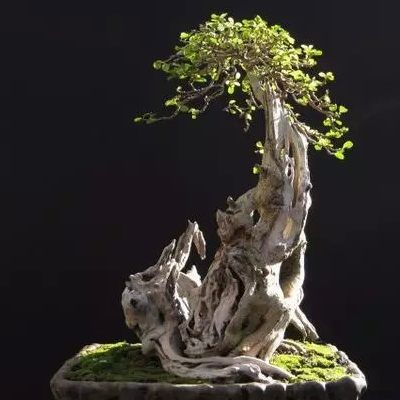What is the price of the culture method of flower bonsai?
Flower bonsai, this is a lot of people like breeding, good to see do not want, flower bonsai breeding method is what? What is the price of flower bonsai:

Culture methods of flower bonsai:
(1) consumers can buy soilless cultivation nutrient solution on the market and dilute it with tap water, use their fingers to push out the roots at the bottom of the basin connected to the soil, soak the roots in water, clean them, and then soak them in the adjusted nutrient solution for about 10 minutes.
(2) prepare the flowerpot and put the perlite into the plant root and straighten it, then fix and decorate it with light ores such as perlite, and gently shake the flowerpot to closely connect the perlite and the root system.
(3) pour the nutrient solution around until the liquid flows out of the hole at the bottom of the basin. Usually use water spray to take care of, do not pour a nutrient solution once a week as a care can make the flower bonsai to maintain a bright appearance. It should be noted that in winter or when the plant is dormant, the nutrient solution needs to be irrigated every month or half a month, and the amount of nutrient solution can be reduced if the flowers can survive in low light.
(4) because of the soilless cultivation, the bonsai does not breed insects or bacteria. The flowers generally grow rapidly, the plants are strong, and they are resistant to cold and heat. Flower bonsai can be applied to hotels, shopping malls or office buildings, and the future is very bright.
Price of flower bonsai:
(1) Yew bonsai, green plant, potted saplings, office flower bonsai, the price is about 40 yuan each.
(2) Orchid potted office potted flowers indoor flower bonsai, the price is about 50 yuan each.
(3) the green potted plants on the desk of succulent plants imported from South Korea are priced at about 22 yuan each.
(4) Ai Juqing makes a fortune, green plants potted flowers indoor asparagus Jasper bonsai, the price is about 18 yuan each.
(5) Green house plant mountain purple nail potted large bonsai indoor green flowers, the price is about 200 yuan each.
(6) succulent bear boy flowers and plants office potted flowers bonsai, the price is about 6 yuan each.
(7) asparagus green leaves bamboo taro green plant potted plants absorb formaldehyde office flower bonsai, the price is about 20 yuan each.
The breeding method and price of flower bonsai are introduced here, so hurry up to raise one in your own home!
Bonsai flower bonsai, common family flower bonsai production method
Bonsai originates from China and is divided into two categories: tree stump bonsai and landscape bonsai. Bonsai is composed of landscape, basin and several (shelves). They are interrelated and influence each other as a whole.
Bonsai is a kind of handicraft which takes trees, rocks and other materials as materials, through artistic treatment and careful training, to reproduce the divine appearance of nature in a typical and concentrated way in the basin. It is known as "silent poetry, painting of the subject". Bonsai is also one of the excellent traditional arts of the Han nationality, which uses plants and rocks as basic materials to express the natural landscape in the basin.
Common bonsai patterns of trees
Bonsai trees
Bonsai is according to the variety of tree growth for the version, and combined with aesthetic taste to cut and refine the bonsai art form of expression, this bonsai can best reflect the poetic and modeling skills of bonsai.
Waterscape bonsai
With all kinds of mountains and rocks as the main materials, after careful selection and processing, it imitates the natural scenery of real mountains and water, decorated in a basin close at hand, showing cliffs, dangerous bees, green streams and other landscapes, like a three-dimensional landscape painting.
Flood and drought bonsai
This kind of bonsai has both water and land, showing the scenery of both land and water.
Rockery potted landscape
Natural stone as the main material, after selection and cutting, carving, splicing and other modeling treatment, embellished with some small plants and furnishings, arranged in the water basin, showing the natural landscape.
Bonsai tree stump
Bonsai stumps are dominated by flowers and trees. The pros and cons of the stump lies in whether its natural form is possible or not, and in the artistic conception and interest contained in the creator's shape. The bonsai tree stump is the epitome of the old mountain stump. Qiu branch is empty, potential is like a wandering dragon, ancient cypress with twisted trunk; loose branches, cliff upside down, branches and leaves like clouds; and bamboo with soft branches, beautiful flowers and fruits, elegant and elegant, are excellent models for making pile scenes.
To make a beautiful pile scene, the key is to choose a good tree stump. The ideal stump is the plant with plump shape, green branches and undehydrated fibrous roots. As far as its shape is concerned, there are straight stem type, cliff type, hanging branch type, co-planting type, horizontal type, orange tip type, free type and so on. Regardless of length, thickness, straight, old and tender, light and dark, dense, thick and thin, should be natural free and easy. Before introducing the stump, it is necessary to select the flowerpot, the principle is that the stump can complement each other.
Banyan bonsai
The banyan tree has a well-developed root system, luxuriant branches and a large canopy. The old banyan tree looks like a big green mountain. The life span of banyan trees is very long, some reach more than a thousand years, and their vitality is quite strong, so it is said that "a single tree becomes a forest". It is suitable for long-term bonsai cultivation and is suitable for viewing all the year round. It is an excellent tree species with heritage significance. And magical and changeable, unique shape, banyan tree is regarded as a symbol of longevity and auspiciousness. Implying the meaning of splendor and wealth. Therefore, the banyan bonsai becomes the best gift for birthday.
Banyan tree is the most beautiful in the root, intertwined, ups and downs, there is no fundamental difference between the root and the tree. Many species of banyan trees have the phenomenon of banding roots, flowers on old stems, hanging gardens and strangling phenomena, and the landscape is strange and majestic. The banyan bonsai is based on the banyan tree, watching the banyan stump and the strange shape of roots and leaves for the purpose, through a variety of techniques to control its growth and development, making it a unique artistic shape of potted banyan bonsai. Below Flower and Tree China net will share with you the production method and daily maintenance of banyan bonsai.
Elm bonsai
Elm is one of the main species of bonsai in Lingnan. It has strong vitality and resistance to pruning and growth rate. Among the five famous trees, Jiuli incense, sparrow plum, Fujian tea, elm and Mantianxing have "thin leaves, dense branches, thick trunk and exposed roots". The four basic conditions for making bonsai can be cultivated into various tree types. Elm is a deciduous tree of Ulmaceae and has a long history of planting in China. More than two thousand years ago, there was the song of "Mountain has pivot Yin and Elm" in the Book of songs.
The shape of elm bonsai can be either in the growing period or in the dormant period, but it is necessary to avoid the budding period so as not to lose too much sap and affect the plant growth. Its form can be processed into straight dry type, curved dry type, oblique dry type, dry type, water-facing type, cliff type, jungle type and other different forms of bonsai according to the basic shape of the stump. The crown can not only be natural, but also can be shaped by a big tree with a dome, and can be processed into a regular disc shape. The modeling method is to tie and cut at the same time, first using wire to tie out the basic shape, and then fine pruning.
Luohansong bonsai
Luohansong bonsai, alias lobular Luohansong, also known as Luohansong, Pinus elliottii, short-leaf sequoia, shrub-like, short and dense leaves, mostly born at the top of the branchlets, with white powder on the back. In the shape of a small tree or shrub, the leaves are short and dense, the branches and leaves are whirling, ancient and delicate, the posture is moving. New shoots sprouted in the growing season, and their tender green leaves were dotted among the thick green leaves. It is quite beautiful and is a kind of excellent bonsai production material, especially for the production of miniature bonsai. Short-leaf Siraitia grosvenorii, alias small Luohansong, Taxodium, often in the shape of a shrub.
In the process of flower bonsai cultivation and management, timely and appropriate removal of leaves will help to improve the ornamental value of flower bonsai, prolong the viewing time, and promote branching and flowering and fruiting. Different kinds of flowers and trees, leaf picking period, leaf picking quantity, leaf picking purpose, the maintenance and application before and after picking leaves are not the same.
Potted plant is one of the main ways of greenhouse flower production. It is easy to control all kinds of living conditions and is beneficial to the promotion and control of flower cultivation. It is also easy to move, which can be displayed indoors and arranged in the courtyard. Potted plants are easy to inhibit the vegetative growth of flowers and promote the development of plants.
Bonsai, common family flower bonsai production methods oh bonsai originated in China, divided into tree stump bonsai and landscape bonsai two categories, bonsai is composed of landscape, basin, several (shelf) three elements, they are interrelated, mutual influence of the unified whole. Bonsai is a kind of handicraft which takes trees, rocks and other materials as materials, through artistic treatment and careful training, to reproduce the divine appearance of nature in a typical and concentrated way in the basin. It is known as "silent poetry, painting of the subject". Bonsai is also one of the excellent traditional arts of the Han nationality, which uses plants and rocks as basic materials to express the natural landscape in the basin. Common bonsai style bonsai tree bonsai is based on the variety of tree growth for the version, and combined with aesthetic taste to cut and refine the bonsai art form of expression, this kind of bonsai can best reflect the poetic and modeling skills of bonsai trees. With all kinds of mountains and rocks as the main materials, the waterscape bonsai is carefully selected and processed to imitate the natural scenery of real mountains and water, decorated in a basin close at hand, showing cliffs, dangerous bees, green mountains, green streams and other landscapes, like a three-dimensional landscape painting. Bonsai such as flood and drought bonsai has both water and land, which comprehensively shows the scenery of both land and water. Bonsai with natural stone as the main material, after selection and cutting, carving, splicing and other modeling treatment, embellished with some small plants and furnishings, arranged in the basin, showing the natural landscape. Bonsai tree stump bonsai is dominated by flowers and trees. The pros and cons of the stump lies in whether its natural form is possible or not, and in the artistic conception and interest contained in the creator's shape. The bonsai tree stump is the epitome of the old mountain stump. Qiu branch is empty, potential is like a wandering dragon, ancient cypress with twisted trunk; loose branches, cliff upside down, branches and leaves like clouds; and bamboo with soft branches, beautiful flowers and fruits, elegant and elegant, are excellent models for making pile scenes. To make a beautiful pile scene, the key is to choose a good tree stump. The ideal stump is the plant with plump shape, green branches and undehydrated fibrous roots. As far as its shape is concerned, there are straight stem type, cliff type, hanging branch type, co-planting type, horizontal type, orange tip type, free type and so on. Regardless of length, thickness, straight, old and tender, light and dark, dense, thick and thin, should be natural free and easy. Before introducing the stump, it is necessary to select the flowerpot, the principle is that the stump can complement each other. Banyan bonsai banyan has well-developed roots, luxuriant branches and a large canopy. The old banyan tree looks like a big green mountain. The life span of banyan trees is very long, some reach more than a thousand years, and their vitality is quite strong, so it is said that "a single tree becomes a forest". It is suitable for long-term bonsai cultivation and is suitable for viewing all the year round. It is an excellent tree species with heritage significance. And magical and changeable, unique shape, banyan tree is regarded as a symbol of longevity and auspiciousness. Implying the meaning of splendor and wealth. Therefore, the banyan bonsai becomes the best gift for birthday. Banyan tree is the most beautiful in the root, intertwined, ups and downs, there is no fundamental difference between the root and the tree. Many species of banyan trees have the phenomenon of banding roots, flowers on old stems, hanging gardens and strangling phenomena, and the landscape is strange and majestic. The banyan bonsai is based on the banyan tree, watching the banyan stump and the strange shape of roots and leaves for the purpose, through a variety of techniques to control its growth and development, making it a unique artistic shape of potted banyan bonsai. Below Flower and Tree China net will share with you the production method and daily maintenance of banyan bonsai. Elm bonsai elm is one of the main bonsai tree species in Lingnan. It has strong vitality and resistance to pruning and growth rate among the five famous trees: Jiuli incense, sparrow plum, Fujian tea, elm and Manchurian star. The four basic conditions for making bonsai are "thin leaves, dense branches, thick trunk and exposed roots". The basic conditions for making bonsai can be cultivated into various tree types. Elm is a deciduous tree of Ulmaceae and has a long history of planting in China. More than two thousand years ago, there was the song of "Mountain has pivot Yin and Elm" in the Book of songs. The shape of elm bonsai can be either in the growing period or in the dormant period, but it is necessary to avoid the budding period so as not to lose too much sap and affect the plant growth. Its form can be processed into straight dry type, curved dry type, oblique dry type, dry type, water-facing type, cliff type, jungle type and other different forms of bonsai according to the basic shape of the stump. The crown can not only be natural, but also can be shaped by a big tree with a dome, and can be processed into a regular disc shape. The modeling method is to tie and cut at the same time, first using wire to tie out the basic shape, and then fine pruning. Luohan pine bonsai Luohan pine bonsai, alias lobular Luohan pine, also known as larch pine, sparrow pine, short-leaf sequoia, shrub-like, short and dense leaves, mostly born at the top of branchlets, with white powder on the back. In the shape of a small tree or shrub, the leaves are short and dense, the branches and leaves are whirling, ancient and delicate, the posture is moving. New shoots sprouted in the growing season, and their tender green leaves were dotted among the thick green leaves. It is quite beautiful and is a kind of excellent bonsai production material, especially for the production of miniature bonsai. Short-leaf Siraitia grosvenorii, alias small Luohansong, Taxodium, often in the shape of a shrub. In the process of flower bonsai cultivation and management, timely and appropriate removal of leaves will help to improve the ornamental value of flower bonsai, prolong the viewing time, and promote branching and flowering and fruiting. Different kinds of flowers and trees, leaf picking period, leaf picking quantity, leaf picking purpose, the maintenance and application before and after picking leaves are not the same.
- Prev

What is the method of making indoor bonsai to put feng shui?
Indoor bonsai, this is a lot of people are in breeding, there is a shape of plants is so good-looking, indoor bonsai production method is what? What is the fengshui of indoor bonsai: how to make indoor bonsai: (1) prepare evergreen plants, fish tanks, stones and soil that need to be planted.
- Next

How to raise bonsai plants? what's the price?
Bonsai plants, which many people like to breed, raise bonsai plants at home, that is a kind of enjoyment, how to raise bonsai plants? How much is the price of bonsai plants: how to raise bonsai plants: 1. How to water is an important factor affecting the growth of bonsai plants.
Related
- Fuxing push coffee new agricultural production and marketing class: lack of small-scale processing plants
- Jujube rice field leisure farm deep ploughing Yilan for five years to create a space for organic food and play
- Nongyu Farm-A trial of organic papaya for brave women with advanced technology
- Four points for attention in the prevention and control of diseases and insect pests of edible fungi
- How to add nutrient solution to Edible Fungi
- Is there any good way to control edible fungus mites?
- Open Inoculation Technology of Edible Fungi
- Is there any clever way to use fertilizer for edible fungus in winter?
- What agents are used to kill the pathogens of edible fungi in the mushroom shed?
- Rapid drying of Edible Fungi

